Methods of Weed Control | Agriculture Optional for UPSC PDF Download
Introduction to Weed Control
- Understanding the nature and habitat of weeds in the area
- Observing how weeds react to environmental changes
- Assessing how weeds respond to herbicides
- Gathering information on:
- Number of viable seeds
- Nature of seed dispersal
- Seed dormancy
- Longevity of buried seeds
- Ability to survive adverse conditions
- Life span of the weed
- Analyzing soil characteristics including:
- Texture
- Moisture levels
- Considering soil suitability for herbicide application:
- Volatile herbicides effective in sandy loam soil, not in clayey soil
- Assessing the effectiveness of flooding as a weed control method:
- Successful in heavy soil
- Not effective in sandy soil
- Evaluating the area to be controlled for effective planning.
Principles of Weed Control
- Prevention
- Eradication
- Control
- Management
Preventive Weed Control
- Prevention encompasses measures to prevent the introduction, establishment, and spread of weeds at local, regional, or national levels.
- Adequate preventive measures are crucial for successful weed control programs.
- Long-term planning is essential for effective and economical weed control and management.
- Recommended preventive control measures include:
- Avoiding the use of crops infested with weed seeds for sowing.
- Refraining from feeding screenings and other materials containing weed seeds to farm animals.
- Avoiding the addition of weeds to manure pits.
- Thoroughly cleaning farm machinery, especially seed drills, before moving them between fields.
- Avoiding the use of gravel, sand, and soil from weed-infested areas.
- Inspecting nursery stock for weed seedlings, tubers, rhizomes, etc.
- Keeping irrigation channels, fence-lines, and uncropped areas clean.
- Exercising vigilance by frequently inspecting the farm for unfamiliar weed seedlings and promptly destroying them by digging deep, burning the weed along with its roots, and sterilizing the spot with suitable chemicals.
- Quarantine regulations in most countries are available to prevent the entry of weed seeds and other propagules into the country via airports and shipyards.
Weed-Free Crop Seeds
Precautionary measures to produce weed-free crops include:
- Separating crop seeds from weed seeds based on physical differences such as size, shape, color, weight/texture, and electrical properties.
- Utilizing air-screen cleaners and specific gravity separators, which differentiate seeds based on size, shape, surface area, and specific gravity.
- Implementing seed certification to obtain certified seeds that are free from contaminant weed seeds, ensuring safe usage.
- Weed laws aid in reducing the spread of weed species and promote the use of well-adapted, high-quality seeds. They protect farmers from using mislabeled or contaminated seeds and legally prohibit seeds of noxious weeds from entering the country.
- Quarantine laws enforce the isolation of areas where severe weed infestations exist and prevent the movement of weeds into uninfected areas.
- Utilizing pre-emergence herbicides helps in prevention as they inhibit the germination of weeds, thereby preventing their establishment.
Eradication
- Eradication refers to the complete removal or killing of a weed species, including its seeds and vegetative parts, from a specific area.
- Successful eradication means the weed will not reappear unless reintroduced to the area.
- Eradication efforts are typically undertaken in smaller areas, such as a few hectares or a few thousand square meters, due to the difficulty and high cost involved.
- Eradication is commonly practiced in high-value areas like greenhouses, ornamental plant beds, and containers.
- Eradication may be considered when the weed species is extremely noxious and persistent, making cropping difficult and economically unviable.
Control
- Weed control involves reducing weed infestations but not necessarily eliminating them.
- Weed control measures aim to achieve varying degrees of success, ranging from poor to excellent.
- In weed control methods, weeds are typically not killed but rather their growth is severely restricted.
- Despite weed presence, the crop is able to produce a normal yield.
- The effectiveness of weed control depends on the characteristics of the weeds involved and the efficacy of the control method employed.
Weed Management
- Weed control aims to suppress existing weeds through physical or chemical means.
- Weed management is a comprehensive system approach involving land use planning to prevent aggressive weed invasion and enhance crop competitiveness.
- Weed control methods are categorized into cultural, physical, chemical, and biological approaches.
- Each weed control method has its own set of advantages and disadvantages.
- No single method of weed control is universally successful in all situations.
- Combining multiple weed control methods often yields more effective and economical results than relying on a single method.
Mechanical Weed Control
Mechanical or physical methods of weed control have been utilized since the early stages of agriculture.
Examples of mechanical methods include:
- Tillage
- Hoeing
- Hand weeding
- Digging
- Cheeling
- Sickling
- Mowing
- Burning
- Flooding
- Mulching
These methods involve physically removing or manipulating weeds to suppress their growth and proliferation.
1. Tillage
- Tillage removes weeds from the soil, resulting in their death.
- It may weaken plants by injuring roots and stem pruning, reducing their competitiveness or regenerative capacity.
- Tillage also buries weeds within the soil.
- Tillage operations include:
- Ploughing
- Discing
- Harrowing
- Leveling
- These operations promote weed germination through soil turnover and exposure of seeds to sunlight.
- Germinated weeds can be effectively destroyed later.
- In the case of perennial weeds, both top and underground growth are injured and destroyed by tillage.
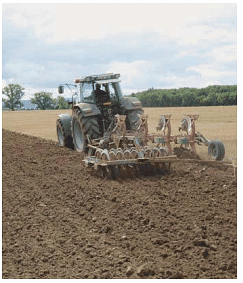
2. Hoeing
- The hoe has been a widely used weeding tool for centuries and remains highly effective and economical.
- It is particularly useful in row crops and supplements the cultivator.
- Hoeing is especially effective on annuals and biennials, as it can completely destroy weed growth.
- However, in the case of perennial weeds, hoeing primarily destroys the top growth while having little effect on underground plant parts.
- This may result in re-growth of perennial weeds over time.
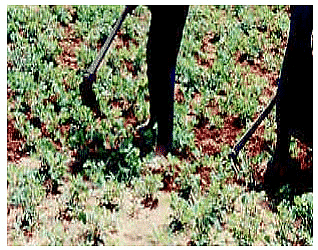
3. Hand weeding
- Hand weeding involves physically removing or pulling out weeds by hand or using implements like khurpi, similar to a sickle.
- Hand weeding is one of the oldest methods of weed control and remains practical and efficient for eliminating weeds in both cropped and non-cropped lands.
- This method is highly effective against annuals and biennials.
- However, it primarily controls the upper portions of perennial weeds and may not fully eradicate them.
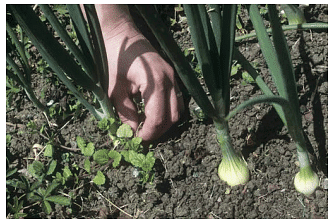
4. Digging
- Digging is a useful method for removing underground propagating parts of weeds.
- It is particularly effective against perennial weeds.
- This method involves digging into the soil to extract the underground parts of weeds from deeper layers.
- By removing the underground parts, digging helps to prevent the regrowth and spread of perennial weeds.
5. Sickling and mowing
- Sickling involves manually removing the top growth of weeds using a sickle to prevent seed production and starve the underground parts.
- It is commonly practiced in sloped areas, where only the tall weed growth is sickled, leaving the root system intact to prevent soil erosion.
- Sickling helps to control weed growth and maintain soil stability in hilly or sloped terrain.
- Mowing is a machine-operated practice typically performed on roadsides and in lawns.
- It involves cutting down weeds and grasses to maintain a desired height and appearance.
- Mowing is effective in controlling weed growth in areas where manual methods are impractical or time-consuming.
6. Burning
- Burning or fire is an economical and practical method of weed control.
- It is utilized to:
- Dispose of vegetation
- Destroy dry tops of matured weeds
- Kill green weed growth in situations where cultivations and other common methods are impracticable.
- Burning effectively removes vegetation, preventing seed production and inhibiting weed growth.
- It is particularly useful in areas where other methods of weed control may be difficult to implement or ineffective.
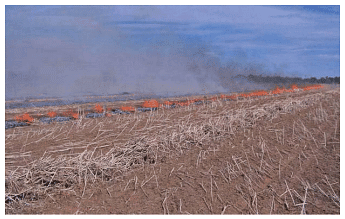
8. Flooding
- Flooding is effective against weed species sensitive to longer periods of submergence in water.
- It kills plants by reducing oxygen availability for plant growth.
- The success of flooding depends on complete submergence of weeds for longer periods.
- Flooding deprives weeds of oxygen, leading to their death and effectively controlling their growth.
- It is particularly successful in areas where weed species are sensitive to water submersion and can withstand longer periods of flooding.

Merits and Demerits of Weed Mechanical Method
Merits of Mechanical Method
- Oldest, effective, and economical method
- Large area can be covered in a shorter time
- Safe method for the environment
- Does not involve any skill
- Weeding is possible in between plants
- Deep-rooted weeds can be controlled effectively
Demerits of Mechanical Method
- Labour consuming
- Possibility of damaging crop
- Requires ideal and optimum specific condition
Mechanical Weeder
Dry Land Weeder:- Used for weeding in row crops to remove shallow-rooted weeds
- Ergonomically designed for easy operation
- Ideal for dryland and gardenland crops with a soil moisture content of 8 to 10%
- Equipped with a 120mm diameter star wheel and a cutting blade for efficient weeding
- Operating width of the blade is 120mm

Power Rotary Weeder:
- Designed for mechanical control of weeds in crops like sugarcane, tapioca, cotton, tomato, and pulses
- Suitable for crops with row spacing more than 45cm
- Consists of three rows of discs with six curved blades in opposite directions
- Blades rotate to cut and mulch the soil, with a coverage width of 500mm
- Depth of operation can be adjusted as needed
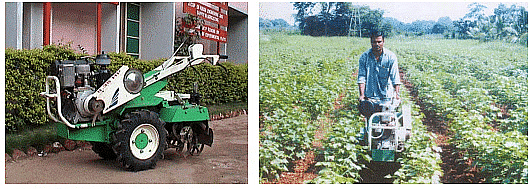
Tractor Drawn Weeding cum Earthing Up Equipment:
- Designed for weeding and intercultural operations between row crops in a single pass
- Equipped with three sweep type blades and ridger bottoms for weeding and earthing up
- Fits onto a standard tractor drawn ridger
- Achieves a weeding efficiency of 61%
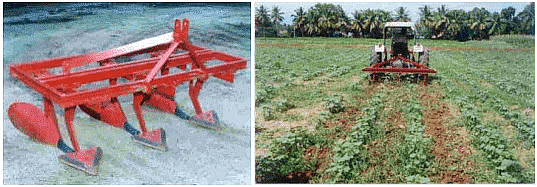
Tractor Operated Multi Row Rotary Weeder:
- Used for weeding and intercultural operations between row crops like sugarcane, cotton, and maize in a single pass
- Consists of cutting blades for weed removal and soil pulverization
- Achieves a weeding efficiency of 71%
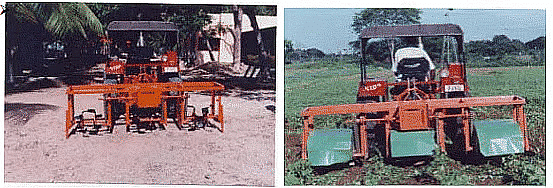
Cono Weeder:
- Designed for weeding between rows of paddy crop
- Features two conical rotors with smooth and serrated blades mounted alternately
- Uproots and buries weeds without a push-pull movement
- Operated by a single operator and does not sink in puddled soil
- Field capacity of 0.18 ha/day
- Also available in star, peg type, and twin hoe wheel weeding configurations.
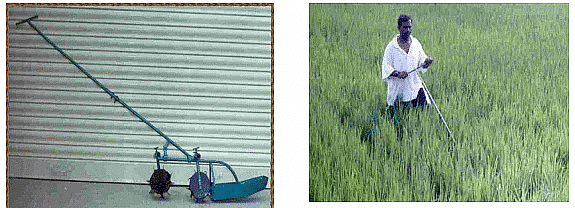
Cultural Weed Control
Field preparation:
- Keep the field weed-free and prevent flowering of weeds to avoid seed buildup.
Summer tillage:
- Off-season tillage effectively checks the growth of perennial weed populations.
- Initial tillage encourages clod formation to desiccate weed propagules, followed by subsequent tillage to break clods and expose weeds to sunlight.
Maintenance of optimum plant population:
- Adequate plant population prevents heavy weed infestation.
- Proper seed selection, sowing method, seed rate, and protection from pests and diseases ensure uniform crop stand for effective competition against weeds.
Crop rotation:
- Crop rotation reduces weed problems by eliminating or reducing the occurrence of specific weed species.
- Including lowland rice in crop rotation effectively controls weeds like Cyperus rotundus.
Growing of intercrops:
- Intercropping suppresses weeds better than sole cropping.
- Short-duration pulses like green gram and soybean effectively smother weeds without reducing the yield of the main crop.
Mulching:
- Mulch suppresses weed growth by excluding light and inhibiting top growth.
- Effective against annual and some perennial weeds like Cynodon dactylon.
- Mulching materials include crop residues, plastic sheets, or polythene film.

Solarisation:
- Utilises solar energy to desiccate weeds by raising soil temperature.
- Pre-soaked fallow fields are covered with thin transparent plastic sheets to raise soil temperature and inhibit moisture evaporation.
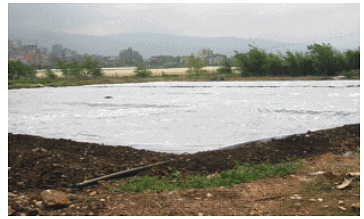
Stale seedbed:
- Destroys initial weed flushes before crop planting.
- Achieved by allowing weeds to germinate and then destroying them with shallow tillage or non-residual herbicides before sowing.
Blind tillage:
- Tillage after sowing but before crop emergence.
- Minimises weed intensity in drill-sown crops where emergence of crop seedlings is hindered by soil crust.
Crop management practices:
- Vigorous and fast-growing crop varieties compete better with weeds.
- Proper fertilizer placement ensures greater nutrient availability to crop plants, disadvantaging weeds.
- Better irrigation practices provide a head start over weeds.
- Proper crop rotation programmes.
- Higher plant population per unit area results in a smothering effect on weed growth.
Merits and Demerits of Weed Cultural Methods
Merits of Cultural Method:
- Low cost for weed control
- Easy to adopt
- No residual problem
- Technical skill is not involved
- No damage to crops
- Effective weed control
- Maintains crop-weed ecosystem
Demerits of Cultural Method:
- Immediate and quick weed control is not possible
- Weeds are kept under suppressed condition
- Perennial and problematic weeds cannot be controlled
- Practical difficulty in adoption
|
52 videos|224 docs
|
FAQs on Methods of Weed Control - Agriculture Optional for UPSC
| 1. What are the principles of weed control? |  |
| 2. What is the significance of preventive weed control? |  |
| 3. What are some methods of mechanical weed control? |  |
| 4. What are the merits and demerits of using mechanical methods for weed control? |  |
| 5. How can cultural weed control be implemented in farming practices? |  |





















